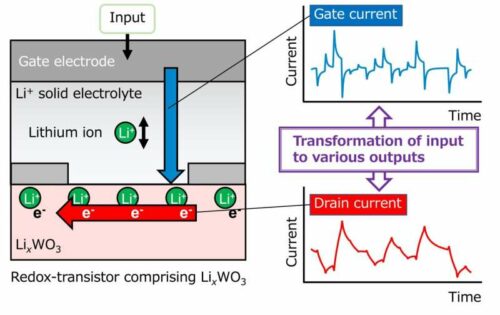Researchers at the Tokyo University of Science and the National Institute for Materials Science have developed an ion-gating transistor with improved reservoir states and short-term memory using redox reactions.

Reservoirs are physical systems designed to mimic neural networks, addressing the requirement for enhanced computational efficiency and speed. The issues with such issues with reservoir systems include compatibility and performance.
Researchers at the Tokyo University of Science (TUS) and the National Institute for Materials Science (NIMS) in Japan have created an ion-gating transistor that exhibits enhanced reservoir states and short-term memory capabilities, utilizing redox reactions. This advancement paves the way for the potential utilization of redox-based ionic devices in high-performance neuromorphic computing. The researchers investigate recognizing complex patterns and relationships in data for developing high-performance “neuromorphic” computing. The approach mimics the brain’s parallel processing and interconnected nature to construct a network that transforms data into high-dimensional representations for tasks like pattern recognition, prediction, and classification.
Physical reservoirs, resembling neural networks, dynamically interact with input signals, neurons, and interconnections undergoing time-based changes. Reservoir states, crucial for transforming input signals into high-dimensional representations, pose challenges in attaining sufficient dimensionality and many states. Ion-gating reservoirs use electrodes and an electrolyte to control ion flow. Applying voltage to the gate electrode triggers a redox reaction, modulating the drain current. Converting time-series datasets into gate voltages generates distinct reservoir states based on the corresponding output currents.
The researchers have used lithium-ion conducting glass ceramic (LICGC) as an electrolyte. LICGC enables faster Li+ ion movement, generating dual currents—drain and gate—doubling reservoir states. Different ion transport rates in channel and electrolyte cause delayed drain current response compared to gate current, enabling short-term memory for information retention and utilization in physical reservoirs. The researchers coated a 200-nm LiCoO2 film to create the device on a 0.15-mm LICGC substrate. The gate electrode was a thin Li-ion/Pt film, while Pt films were drain and source electrodes. The channel connecting the drain and source had a 100-nm WO3 thin film.
The device achieved 40 reservoir states, surpassing memristors and spin torque devices in solving second-order nonlinear dynamic equations. The device’s nonlinearity, memory, and great reservoir states resulted in a low mean square prediction error (0.163) in the NARMA2 task—a benchmark for complex nonlinear operations and time-series prediction.
Reference: Tomoki Wada et al, A Redox‐Based Ion‐Gating Reservoir, Utilizing Double Reservoir States in Drain and Gate Nonlinear Responses, Advanced Intelligent Systems (2023). DOI: 10.1002/aisy.202300123








